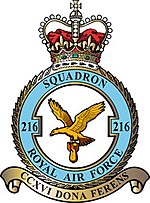Number 216 Squadron is a squadron of the Royal Air Force based at RAF Waddington, Lincolnshire, since reforming on 1 April 2020 and is tasked with testing future drone swarm technology. It had previously operated Lockheed TriStar K1, KC1 and C2s from RAF Brize Norton, Oxfordshire, between November 1984 and March 2014.
| No. 216 Squadron RAF | |
|---|---|

| |
| Active | 5 October 1917 – 1 April 1918 (RNAS) 1 April 1918 – 27 June 1975 (RAF) 1 July 1979 – 20 March 2014 1 April 2020 – present |
| Country | |
| Branch | |
| Type | Drone swarm technology |
| Role | Test & Evaluation |
| Home station | RAF Waddington |
| Motto(s) | CCXVI dona ferens (Latin for '216 bearing gifts')[1] |
| Battle honours |
|
| Insignia | |
| Squadron badge | An eagle, wings elevated, holding a bomb in its claws. Approved by King Edward VIII in May 1936.[2] |
| Squadron codes | VT (Apr 1939 – Sep 1939) SH (Sep 1939 – Sep 1941) |
No. 216 Squadron's beginnings can be traced back to August 1917 when No. 7 Squadron of the Royal Naval Air Service (RNAS) sent a detachment of four Handley Page O/100toRedcar in order to fly anti-submarine missions. Moving to Manston in October, the unit was re-designated as 'A' Squadron.[3] At the end of October, 'A' Squadron was deployed to Ochey, France, joining No. 41 Wing as a strategic night bomber squadron.[4] On 8 January 1918, 'A' Squadron was re-designated as No. 16 Squadron (RNAS).[5] In March, the squadron began to convert to the Handley Page O/400.[6] On the night of 24/25 March, an aircraft from the squadron carried out an 8 and a half hour attack on Cologne.[3] On 1 April, while operating out of Villeseneux (south east of Reims), No. 16 Squadron (RNAS) became No. 216 Squadron of the Royal Air Force.[5]
Between the two World Wars the squadron used Vickers Vimy, Vickers Victoria and Vickers Type 264 Valentia aircraft on transport duties around the Middle East. No. 216 Squadron had their squadron badge approved by King Edward VIII in May 1936.[5]
During the Second World War, with a few exceptions, such as the attacks from 17 to 21 June 1940 by a single aircraft of No. 216 Squadron on the airfields of El Adem and Tobruk,[7] the unit was principally a transport squadron, operating the Vickers Type 264 Valentia, Bristol Bombay, de Havilland DH86, Lockheed Hudson and Douglas Dakota. It spent a lengthy time deployed to Cairo from November 1942 to July 1945.[8]
In late 1949, the Dakotas were replaced by Vickers Valettas transport aircraft; in 1955 the squadron moved to RAF Lyneham from RAF Fayid in Egypt to operate the De Havilland Comet C.2 jet airliner until 27 June 1975, when No. 216 Squadron disbanded after 58 years of service.[5]
The squadron reformed at RAF Honington on 1 July 1979 as a maritime strike squadron assigned to Supreme Allied Commander Atlantic (SACLANT) with twelve Blackburn Buccaneer S.2[9] aircraft transferred from the Fleet Air Arm's 809 Naval Air Squadron. These aircraft had been embarked on HMS Ark Royal[10] until flying off for the last time in November 1978 for a delivery flight from the carrier in the Mediterranean to RAF St Athan. Designated Buccaneer S2A by the RAF, they were equipped with twelve WE.177A nuclear bombs,[11] free-falling conventional HE bombs and Martel missiles for non-nuclear strike. However, on 7 February 1980, a No. XV Squadron Buccaneer crashed after a wing failed in flight during the Red Flag exercise in the USA.[12] The resulting grounding and inspections saw the size of the Buccaneer fleet reduced, with the result that No. 216 Squadron had its assets merged with No. 12 (Bomber) Squadron barely a year after its reformation, however the squadron was not officially disbanded.[5][13]
Following the Falklands War, the RAF found itself lacking in the strategic transport capabilities required to sustain the expanded military presence there; this shortfall was filled initially by chartered British Airways Boeing 747s and Britannia Airways Boeing 767s. To address this, in December 1982 the RAF purchased six former British Airways Lockheed TriStar 500s. The first TriStar (ZD949) was leased back to British Airways on 29 March 1983 until November, eventually undergoing conversion at Cambridge AirportbyMarshall Aerospace in 1986.[14] In 1984, the RAF purchased a further three TriStar 500s from Pan-Am.[15]
No. 216 Squadron was reactivated on 1 November 1984 at RAF Brize Norton to operate the Lockheed TriStar.[5] The aircraft were operated initially in the air-transport role but the fleet's role was eventually expanded to air-to-air refuelling.[16] On 24 March 1986, TriStar KC.1 ZD953 became the first aircraft to be handed over to the squadron.[17]
No. 216 Squadron deployed the TriStar fleet in support of many high-profile missions including the Gulf War (for which the aircraft received a desert paint scheme), Operation Allied Force (Kosovo), Operation Veritas and Operation Herrick (Afghanistan), Operation Telic (Iraq 2003) and Operation Ellamy (Libya).[18]
The squadron was disbanded on 20 March 2014 at RAF Brize Norton,[19] with the last Tristar sortie being flown on 24 March.[20] In October 2017, it was announced that Queen Elizabeth II had approved the award of 'Iraq 2003–2011' and 'Libya 2011' battle honours to No. 216 Squadron (without the right to emblazon).[21]
On 17 July 2019, at the Air & Space Power Conference, the RAF announced that No. 216 Squadron would reform to become an experimental unit that will test future drone swarm technology.[22][23][24] No. 216 Squadron formally stood up on 1 April 2020 at RAF Waddington, Lincolnshire.[25] In March 2024, James Cartlidge, the minister for defence procurement, informed Parliament that notwithstanding its formation in 2020, 216 Squadron had “completed [no] tests or trials [of any drones] ... either in-house or with industry” since being reconstituted.[26]
Aircraft operated include:[27][28][14][29]